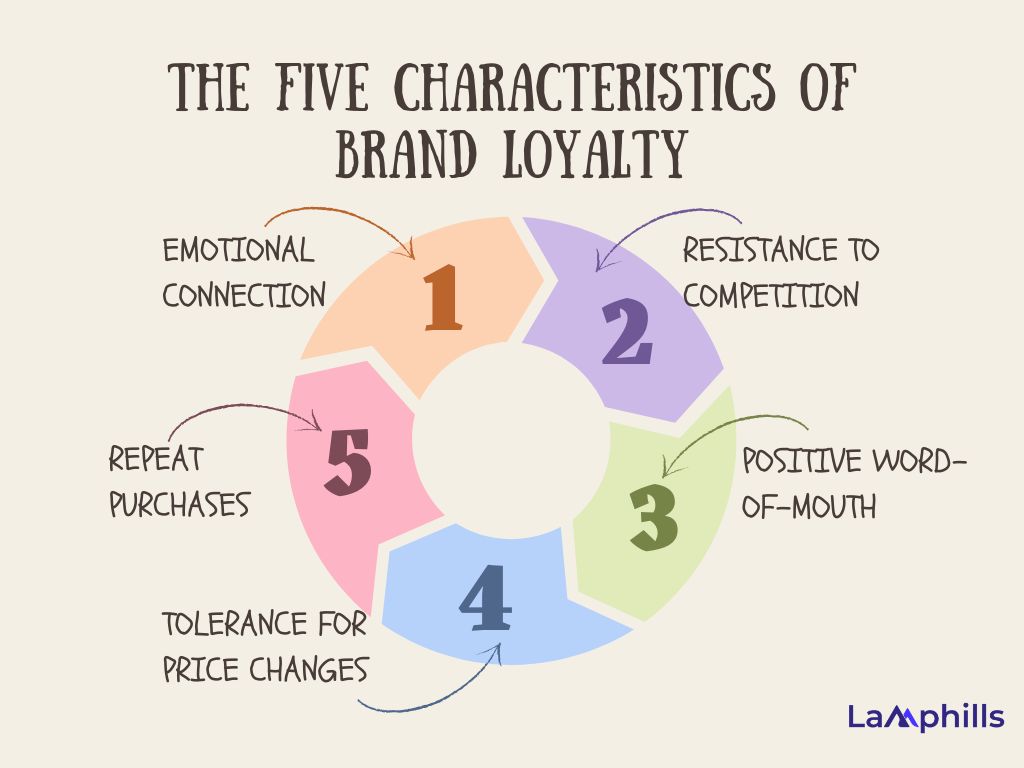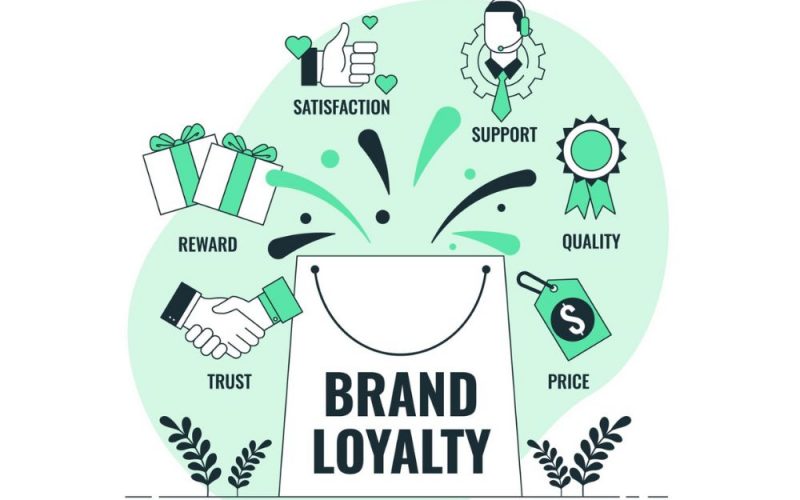Do you sometimes look at a brand, and wonder how they’re able to maintain a consistent level of brand loyalty spanning decades? Take Apple, for example; despite the pricey nature of its products, the brand’s customers remain loyal and consistently choose it over other cheaper competitors.
The primary reason that brand loyalty is so important to profitability is straightforward: 65% of revenue in most companies comes from repeat business with existing clients. Not only do existing customers loyal to brands purchase 90% more frequently than new customers, but maintaining the brand-loyal segment is also far less expensive than marketing to attract new customers.
If your goal is to achieve this level of loyalty with your customers, well, the first thing you should know is that such loyalty doesn’t come overnight. Luckily, it is very much achievable with a few thought-out strategies.
Key Takeaways
- Brand loyalty describes a consumer’s inclination to keep choosing a specific brand, even in the face of competitive offers or challenges.
- Unlike customer loyalty, which is money-based (prices and discounts), brand loyalty is perception-based (image and experience).
- Brand loyalty starts with recognition, then advances to brand preference and brand insistence.
- A customer’s brand loyalty consists of emotional connection, resistance to competition, positive word-of-mouth, tolerance for price changes and repeat purchases.
- Brand loyalty can drive brand affinity through positive word-of-mouth recommendations.
What Is Brand Loyalty?
Brand loyalty represents the positive emotional association that consumers attach to a specific product or brand. It describes a consumer’s inclination to keep choosing a specific brand, even in the face of competitive offers or challenges. This loyalty is often a result of the value a brand offers to its consumers.
No matter the competitor’s efforts, a loyal customer stays devoted to a product or service of their choice. They demonstrate that by repeating purchases, despite the numerous, more affordable, or accessible options.
Unlike customer loyalty, which is money-based (prices and discounts), brand loyalty is perception-based (image and experience). Brand-loyal customers believe that a certain brand represents both higher quality and better service than any competitor—and the price does not matter. Brand-loyal customers might make fewer total purchases, but the profit margins on their purchases are larger.
Once established, brand loyalty is fairly easy to retain—assuming, of course, that product quality and service level remain high. Brand loyalty is also less expensive to retain than customer loyalty, which requires constantly offering low prices and regular discounts to maintain best-deal-on-the-market status.
Levels of Brand Loyalty
Not all brand loyalists are created equal. This section breaks down how someone can start as someone who simply knows your brand to someone who is loyal to it.
Brand recognition
Recognition is the first step in brand loyalty.
Before a consumer can form an impression of your brand, they first need to be exposed to it. Once they recognize your brand, it may be the first thing that comes to mind when thinking of a certain product or service.
For instance, you may not spend a lot of time shopping for jewelry, but you might recognize Tiffany & Co. and associate it with luxury, romance, and beauty. This recognition is due to the brand’s extensive marketing efforts to become a household name and reach audiences that align or fall outside of their ideal buyer persona.
First impressions can last. So, if you’re looking to build a loyal audience, it’s important that you invest your resources in making those initial touchpoints positive. Given the digital age we live in, this is most likely through your website and social media accounts.
Brand preference
When someone prefers your brand, it means they’ll choose your brand over another if all things are equal. However, they may still be swayed by competitors taking additional steps to appeal to your audience.
This is why it’s important to create a robust brand identity and maintain it at every point in your company’s growth.
Brand insistence
At this level, your brand is no longer compared to other competitors. It’s the highest level of loyalty and the level every business is striving for with its audience.
While a brand loyalist can reach brand insistence without ever purchasing a product, this is most common in customers. Suppose a consumer already identifies with your brand and you provide an easy shopping experience plus a good product or service. In that case, you can turn a one-time buyer into a brand evangelist.
The Five Characteristics of Brand Loyalty
A customer’s brand loyalty consists of five distinct characteristics that inform how they engage with your brand. These include:

Emotional connection
Have you ever gone out of your way to get to your favorite coffee shop? It feels silly, but the emotional attachment between a person and their favorite beverage is no joke. It’s your favorite for a reason.
Maybe their service is incredibly consistent, or maybe they nail emotional marketing plays that speak to being cozy and comfortable. Whatever it is, it’s created a personal connection that has fueled a lasting relationship.
Resistance to competition
Brand loyalty makes customers less likely to be swayed by competitive offers because they believe the value your brand offers is greater than anything a competitor can provide.
After several positive experiences with their chosen business, brand loyalists view that brand as more valuable. They’re confident that the brand will consistently meet their needs and offer better quality, which makes them less inclined to explore other options.
Positive word-of-mouth
The greatest influencers are often our co-workers, family members, and friends. That’s what makes positive word-of-mouth recommendations so powerful.
It’s not uncommon for brand loyalists to sing the praises of their preferred business, and their love isn’t restricted to casual conversations either. Digital word-of-mouth recommendations are also common, and can look like this:
- Social media shout-outs and praise
- User-generated content
- Positive reviews
- Brand ambassadorship
Tolerance for price changes
Inflation. Supply chain issues. Market headwinds. Price changes are often the outcome of several contributing factors that businesses have little to no control over.
If yesterday’s price simply can’t be today’s price, brand loyalty can be a helpful buffer against price sensitivity. This allows brands to adjust pricing to maintain profitability without losing their most loyal customers.
Repeat purchases
The four characteristics we’ve covered thus far work together to encourage repeat purchases and customer retention.
Nothing encapsulates this phenomenon quite like the “If I like it, I’ll just grab it in a different color” TikTok trend. After the audio (originally shared by user @justsaraslife) took off on the platform, more than 39,000 people used it to show their dedication to the brands and products that they love.
That’s the power of brand loyalty. It keeps people coming back, even if it’s for the same thing.
How To Build Brand Loyalty That Lasts
There are plenty of marketing tactics that companies use to improve brand loyalty, including rewards programs, having a strong brand story, community building and more.
The checklist below goes in-depth into some of the best ways to build lasting brand loyalty.
How To Build Brand Loyalty That Lasts
How Does Brand Loyalty Impact Consumer Behaviour?
Consumers experience different phases when buying from certain brands. They constructively check product information, packaging, quality, and company details and also evaluate multiple brands before making a final purchase decision.
However, what drives a person to consistently buy from a brand rather than a competing brand is the trust earned over time.
Brand loyalty is simply regarded as the consumer’s perception of a brand. It is what drives consumers to buy a particular type of product repeatedly instead of choosing a competitor. Over time, as the consumer gets familiar with the brand, their behavior will be influenced because of their love for the brand.
Here are some of the ways a consumer’s behavior can be influenced when a brand maintains its loyalty:

Leads to better consumer engagement
Brand loyalty drives large consumer engagement. The majority of consumers will always give the audience and also, want to be identified with a brand that has maintained its loyalty to them over time. They tend to give full support to a brand they love.
They also engage more frequently on social media platforms and are always willing to participate in events, competitions, surveys, and loyalty programs organized by the brand.
Consumers recommend your brand to their network
This is also known as word-of-mouth referral. According to a statistic by Gensler, 94% of individuals said they would highly recommend a brand they were emotionally engaged with. Their love for a brand usually influences their friends and family’s behavior.
Consumers always tend to recommend and act as ambassadors for a brand that has maintained its loyalty. Manufacturers won’t be spending too much on marketing because they will act as brand marketers to people within their circle of influence. They will not only recommend a loyal brand but also ensure that everyone gets associated with it.
You get more repeat purchases from consumers
Individuals who are familiar with a specific brand will tend to come back and buy more products. The majority of consumers will likely come back to buy from a brand that has remained loyal over time. Even when there is a price increase, they will always come back and buy that same product instead of choosing a competitor.
Consumers are more willing to try your new products
Statistics show that 59% of shoppers prefer to buy new products from brands they are familiar with. Consumers will always anticipate the release of a new product and are more likely to try out a new product from a brand they love.
Your consumers spend significantly more
Have you ever wondered why you keep paying more money to buy a certain brand of noodles rather than other types of noodles regardless of the price increase? It is simply because you know that you will get value for your money.
Price doesn’t act as a constraint for a brand-loyal consumer because they know they will always get value for their money.
Why does brand loyalty matter?
According to The 2023 State of Social Media Report, the top priority for business leaders in today’s economic environment is building brand reputation and loyalty.
As market competition heats up and consumers become pickier about what they buy, brand loyalty helps ensure that your product or service doesn’t end up on the chopping block. The loyalty of your top customers is what keeps them from being tempted by other offers, acting as a protective shield that prevents competitors from chipping away at your market share.
Brand Loyalty Examples
When was the last time you used a search engine other than Google to search for something? For me, I can’t remember.
And it’s not because the interface or user experience is wildly different on other search engines. Somehow, Google has built this loyalty from online users which has made it the number one search engine in the world.
Le Creuset
How much bakeware could one person possibly need? To a Le Creuset fan, the limit does not exist.
For nearly 100 years, the French kitchenware brand has been a mainstay for chefs and home cooks alike. Obtaining your first Le Creuset Dutch oven is a momentous occasion for many, but it doesn’t stop there. Fans continuously flock to seasonal releases, hoping to get their hands on the latest and greatest in enamel-covered dishes.
So what makes these dishes so special? Quality aside, the brand taps into its audience’s emotional needs.
The art of cooking is already deeply rooted in care and connection, giving Le Creuset an easy into their audiences’ hearts and minds. Layer in their reputation for reliability along with some cozy visuals of simmering pots and delicious meals, and you get a diehard fan base of brand loyalists.
Apple
Apple is described as having a cult-like brand following, as its audience is so dedicated that nothing or no one can persuade them to go elsewhere. The brand appeals to consumers who value innovation, creativity, and minimalism.
Apple has maintained a consistent brand identity since its inception in the late ’70s, and that is likely one of the keys to its success.
Slack
Brand loyalty isn’t exclusive to B2C brands, and Slack proves it.
Over 100,000 organizations use the business messaging tool to connect their workforce, and professionals across industries swear by it. While the product itself is impressive, what truly sets the company apart for many fans is its unique voice and tone.
Slack seizes every opportunity to reinforce its brand’s distinctive voice. When you interact with them online, they come across as your favorite coworker—friendly, smart and genuinely human. According to their brand microsite, their voice is at the core of their brand identity, and they approach everything with genuine warmth and care, even their app release notes.
Marks & Spencer
How do you reinvent a brand that’s more than a century old? That’s the question Marks & Spencer, a UK-based retailer specializing in clothing, beauty and home products, had to answer in 2019 after dropping from the FTSE 100 for the first time since the city share’s index began in 1984.
Fast forward to today and you’ll see a company back on the up, largely due to an omnichannel customer experience strategy that creates cohesion across its many offerings.
To bring the brand into the digital age, Marks & Spencer introduced an app-based loyalty program in 2022. The program, called Sparks, treats loyal customers to gifts, prizes, personalized offers, charitable donations and more.
The M&S team came up with these benefits by listening to audience feedback and experimenting with incentives to get them in-store—and so far, it’s working. More than 4.3 million active users turn to the Sparks app to stay connected with the retailer.
Brand loyalty vs. brand affinity
Brand affinity is the belief that a business aligns with the values or principles of its customers. While brand loyalty refers to the actions consumers take with a specific brand, brand affinity encompasses the emotional ties between consumers and a brand.
So which is more important? The answer is both. Brand affinity drives brand loyalty by forging deeper connections between a brand and its consumers. Similarly, brand loyalty can drive brand affinity through positive word-of-mouth recommendations.
Recommended Articles
- How to Monitor Competitors in 10 Effective Steps
- Unveiling the Power of Publicity: A Comprehensive Guide
- Unlocking the Power of Brand Equity: A Comprehensive Guide
- Brand Authority: How to Elevate Your Reputation and Stand Out
- How To Build & Measure Brand Affinity: The Ultimate Guide to Fostering Lasting Connections
- How To Write A Personal Brand Statement Defines Your Professional Journey (With Free Templates)







